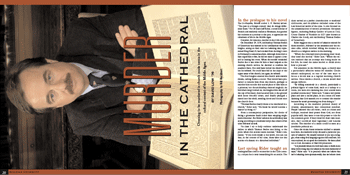Murder in the Cathedral
 In the prologue to his novel The Go-Between, British author L. P. Hartley writes: “The past is a foreign country: they do things differently there.” For 20 years Jeff Rider, a noted scholar of French and medieval studies at Wesleyan, has guided his students in a journey to the past, to appreciate the otherness of life in the Middle Ages.
In the prologue to his novel The Go-Between, British author L. P. Hartley writes: “The past is a foreign country: they do things differently there.” For 20 years Jeff Rider, a noted scholar of French and medieval studies at Wesleyan, has guided his students in a journey to the past, to appreciate the otherness of life in the Middle Ages.
Consider, for instance, murder in the 12th century.
On December 29, 1170, Archbishop Thomas Becket of Canterbury was warned in his bedchamber that four knights, acting on their own but believing they represented King Henry II, had traveled from the king’s court in Normandy to assassinate him. Although those loyal to him urged him to flee, he did not want to appear a coward by leaving his room. When the monks reminded Becket that it was time for him to hear vespers at the evening church service, he decided to confront his attackers there. He could have locked the church door, but he refused. He could have hid in the crypt or the upper areas of the church, but again, he refused.
The four knights entered the church with swords drawn, calling Becket a traitor. They would have preferred to remove him from the church, perhaps to murder him outside this sacred place or take him as a prisoner, but the archbishop resisted mightily. As horrified clergy looked on, the knights first sliced off the top of his head, then battered him to the ground with more forceful blows, and finally plunged a sword into his skull, sending blood and brains onto the church floor.
“Thomas Becket clearly chose to be murdered in a church,” Rider says. “He knew he would become a martyr by doing so.”
From a contemporary perspective, his choice of facing a gruesome death rather than escaping might seem irrational. But Rider believes the archbishop was acting according to a medieval script that others of his time followed as well.
“In class I try to help students understand the milieu in which Thomas Becket was living, to the point where his actions seem rational,” Rider comments. “If you look closely at his world, you can see that, in the context of his time, these were not the actions of a fanatic or a disturbed individual.”
Last spring Rider taught an undergraduate course on murder in the 12th century, a subject he is now researching for an article. The class served as a perfect introduction to medieval civilization, and its syllabus included some of the best historical works of the time. It also focused on the assassinations of several prominent European figures, including Bishop Gaudry of Laon in 1112, Count Charles of Flanders in 1127 (also known as Charles the Good), and Archbishop Thomas Becket of Canterbury.
Rider suggests that a model of behavior existed for these murders, followed by the assassins and the victims alike, which involved killing the victims in a church at a religious service in the morning.
“When the criminals were planning their deed, they used this model,” Rider says. “When the victim realized that an attempt was being made on his life, he used the same model to think about how to proceed.”
For assassins in the Middle Ages, a church was a particularly effective venue for murder. Clocks weren’t widespread, so one of the best ways to locate a victim was at a regular morning church service. Once inside a church, a victim would find escape difficult.
“By killing somebody in a church, particularly a political figure of some kind, such as a bishop or a count, you were also claiming that your actions were justified in some way,” Rider says. “It was a very public place and also a sacred place, so in a sense you were claiming that God wanted you to commit the murder because he wasn’t preventing you from doing it.”
According to the medieval political theory of tyranny, assassination was sometimes justified. People believed that all rulers, such as counts and bishops, received their power from God, not from popular will; they were to use this power to rule for the common good. If they ruled for their own interests, they sacrificed their legitimacy and became tyrants. The murder of a tyrant could be seen as a justifiable political act.
Once the victim knew someone wished to assassinate him, the medieval script dictated a particular pattern of behavior. He initially resisted or put up a struggle, often using foul language against his attackers, but once stabbed, he accepted the inevitable. He then called out to God, the saints, or Mary for protection.
“It is precisely when you don’t have time to think about what you’re doing that you behave in the most traditional of ways,” Rider says. “It is precisely when we believe that we’re behaving most spontaneously, that we behave most generically, in ways that we’ve seen people behave previously or in ways that we’ve heard about before.”
Rider hopes that this close study of human behavior in the Middle Ages will encourage his students to reflect on how their own actions in the present may follow certain prescribed patterns influenced by cultural models. He also urges them to reflect on the differences in behavior between then and now.
“In the Middle Ages, people were more oriented toward actions that happened in public placesa€”rituals and ceremonies and so on,” he says. “We’re more oriented toward private actionsa€”talking to people individually, making phone calls, doing things in private with friends.”
In spite of the differences, Rider believes he can help students recognize the similarity of humanity everywhere and at different times.
“I may not comprehend why a person in the past acted in a certain way at first, but eventually I may understand him,” he says. “No human behavior is totally irrational.”
For the last 10 years, Rider has worked on a series of projects related to the assassination in 1127 of Charles the Good, the Count of Flanders in Belgium, while he prayed in his church. Rider’s book, God’s Scribe, deals with Galbert of Bruges, one of the chroniclers of the assassination. Rider first learned about Galbert when he studied at the Catholic University of Louvain in Belgium in the late ’70s. He was asked to work on a new edition of Galbert’s journal, which required him to compare many written copies of the medieval text in an effort to figure out what the original version had been.
Galbert of Bruges, who was most likely a cleric in the fiscal administration of the Count of Flanders, wrote a diary during 1127a€“28, the only existing journal from this time. His journal contains one of the few contemporary accounts of the count’s assassination and its aftermath, which included the capture and punishment of the assassins. Some 160 people were involved in the murder, including members of the most important family in the county. The event was a major scandal and eventually the King of France intervened to appoint a new count, who proved so unpopular that the citizens of Flanders rebelled and installed their own count. Galbert wrote about all these events in his journal.
“Galbert’s work is particularly significant since we don’t have anything else like this from the Middle Ages,” Rider says. “In his journal, we have somebody who is in the center of things, who’s educated and knows how to write.
“To have this level of information about this time and place is highly unusual,” Rider adds. “Because he’s writing for a whole year, you find depth and kinds of information you don’t get anywhere else. He describes architecture, water mills, what people had in their cellars.”
During the 20th century, most scholars considered Galbert to be an objective observer who just copied down what he heard and saw. Rider disagrees. In God’s Scribe, he asserts that although the book is written in the form of a diary, it was not spontaneously produced. Instead, Galbert crafted his material very carefully, introducing a variety of narrative themes and political ideas. He also used narrative techniques that are curiously modern, such as imaginatively recreating the murder from the point of view of the assassins.
“He’s an original writer, the only person in the Middle Ages who thought of writing history in the form of a journal,” Rider says. “But it is this very originality that makes it so difficult for us to perceive his brilliance. His work seems transparent and na??ve. In fact, to achieve that effect requires immense sophistication.”
Rider notes in God’s Scribe that Galbert’s great achievement was “the composition of a bundle of gripping narratives that he managed to recount simultaneously within the original journalistic form he had created.” From Rider’s book, it becomes apparent that the journal is a meticulously organized history that was revised thoroughly.
“You see Galbert thinking about the same set of questions and problems over a period of time,” he says. “For instance, when a count dies without an heir, how does one choose the next count? In the diary, we witness a medieval person’s thinking over a period of a yeara€”a rare privilege.”
Rider believes many of us, not just his students, may learn from studying human behavior and narratives of the past.
“The people in the 12th century were just as sophisticated and intelligent as we area€”perhaps, in some ways, more so. When we understand the stories of the past, we can understand the behavior of the past,” he says. “But also by reading stories of the past, we’re making our own narrative reservoir richer and more complex, and therefore we’re able to understand the actions of the present in a more complex way.
“Imagine how impoverished we would be if we only read or saw or heard recent stories that were intended only for us,” he adds. “By reading or hearing stories that weren’t made just for me, my world becomes richer, and I can see things from different points of view.”
Rider hopes that when students come to his classes, they observe how he interacts with a book and learn a certain kind of behavior or comportment from his interaction. He would like them to ask: “Am I being polite, am I being considerate, am I being open to that booka€”or am I trying to dominate it?” He thinks the way his students interact with a book can serve as a model for how they interact with people. He wants them to ask: “Am I being respectful of that other book and that other person?”
He also hopes his students learn to respect the past.
“I think an awareness of the past first of all produces humility because you realize that not all ideas were created in the last 20 years,” he says. “Secondly, it creates a sense of solidarity with the people in the past. You realize they were human beings just like you and there’s a link between you and them. In some sense, you’re responsible for them because if you forget them, who’s going to remember?”

